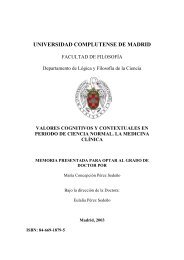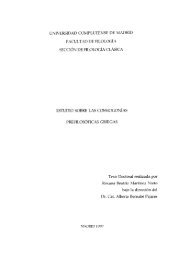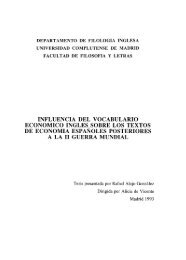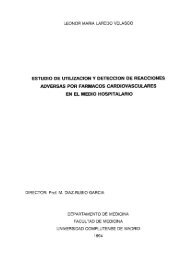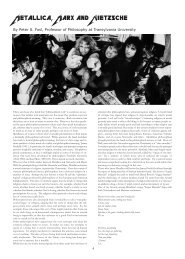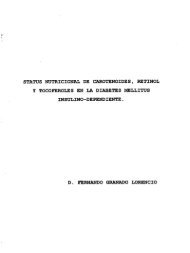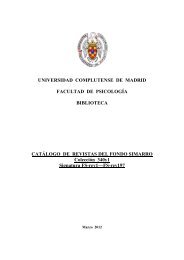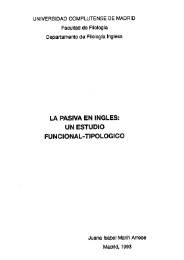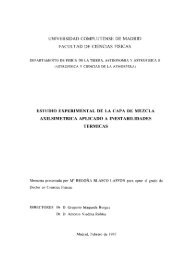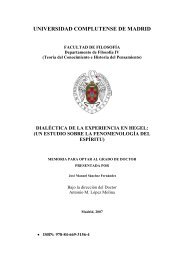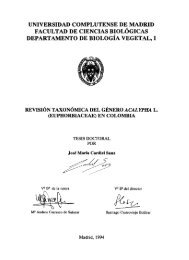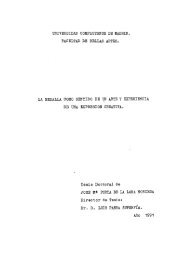- Page 1 and 2:
Estudio de la dinámica del humor a
- Page 3 and 4:
Don Pedro Corsino Fernandez Vila, P
- Page 5 and 6:
AGRADECIMIENTOS - Al Prof. P.C. Fer
- Page 7 and 8:
Índice.
- Page 9 and 10:
3.- Fluorofotometría del segmento
- Page 11 and 12:
3. Relación de F y PIO. La pseudof
- Page 13 and 14:
1. Dinámica del humor acuoso y Gla
- Page 15 and 16:
El epitelio ciliar lo forman dos pl
- Page 17 and 18:
La difusión de ciertas substancias
- Page 19 and 20:
Tampoco por este mecanismo se expli
- Page 21 and 22:
Davson62 idea en 1950 un sistema de
- Page 23 and 24:
(forma no fosforilada) permite el p
- Page 25 and 26:
inhibidor selectivo de la Na/K-ATPa
- Page 27 and 28:
Otras substancias, como aminoácido
- Page 29 and 30:
extiende desde la zona endotelial,
- Page 31 and 32:
Entre el endotelio de la pared inte
- Page 33 and 34:
irregularmente por su pared externa
- Page 35 and 36:
ya determinado el gradiente de pres
- Page 37 and 38:
administradas por vía exógena, de
- Page 39 and 40:
Sistema colinérgico. Los agonistas
- Page 41 and 42:
puede ser inhibido por el propanolo
- Page 43 and 44:
mensajero, el AMPc y la fosforiliza
- Page 45 and 46:
3. Receptores fi del epitelio cilia
- Page 47 and 48:
de la producción del humor acuoso
- Page 49 and 50:
dosis administrada, su concentraci
- Page 51 and 52:
Desde un punto de vista práctico,
- Page 53 and 54:
Otros factores que afectan a la for
- Page 55 and 56:
A. Generales. 1. Edad. 2. Nocturno.
- Page 57 and 58:
d) Alteraciones dinámicas en el gl
- Page 59 and 60:
Estudios citoquimicos han demostrad
- Page 61 and 62:
2.- Métodos de estudio en la diná
- Page 63 and 64:
Flg 7. Forma de acción del goniopr
- Page 65 and 66:
El método fue desarrollado por Bar
- Page 67 and 68:
difundir desde el humor acuoso a es
- Page 69 and 70:
En un ojo en reposo, la entrada y l
- Page 71 and 72:
La producción del humor acuoso dis
- Page 73 and 74:
El valor de C puede ser tambien det
- Page 75 and 76:
3.- Fluorofotometría del segmento
- Page 77 and 78:
el amperímetro y son anotados cada
- Page 79 and 80:
La fluorescencia es proporcional a
- Page 81 and 82:
estroma corneal, del que se libera
- Page 83 and 84:
FLUOROTRON .METRIC. Fabricante COHE
- Page 85 and 86:
muestra un pico de unos 15 ngr/ml,
- Page 87 and 88:
1000 Pb PS 100 10 o oculares o por
- Page 89 and 90:
Q Fa Rl Va 0 4 8 horas FIg. 18. Det
- Page 91 and 92:
1000 100 lo o totomia radial, así
- Page 93 and 94:
Se necesita conocer el valor de la
- Page 95 and 96:
otro indiferente. El modelo cinéti
- Page 97 and 98: Este par de valores permiten obtene
- Page 99 and 100: Los fundamentos sobre los que se ba
- Page 101 and 102: III. Material y Métodos.
- Page 103 and 104: Las características de cada grupo
- Page 105 and 106: - Valor máximo y mínimo de la Pí
- Page 107 and 108: Consta de los siguientes elementos:
- Page 109 and 110: La Fig. 25 representa la cabeza del
- Page 111 and 112: 3.- Cambio de parámetros para la r
- Page 113 and 114: en una exploración normal supone u
- Page 115 and 116: Donde: dC a dt - t es el tiempo.
- Page 117 and 118: C es una constante corneal. A xB =
- Page 119 and 120: Sustituyendo (15) en (10): A= ~CaXV
- Page 121 and 122: Y el flujo del humor acuoso es igua
- Page 123 and 124: 2.- Por métodos ópticos (Jones y
- Page 125 and 126: solo el valor comparativo del flujo
- Page 127 and 128: - Que las rectas sean paralelas (el
- Page 129 and 130: - F : flujo de Humor Acuoso - Q : C
- Page 131 and 132: 5.- Hojas de protocolo. A fin de re
- Page 133 and 134: Gon 1 oscopi a. Superior Inferior O
- Page 135 and 136: Caso Fi ucrofotoMetrí a. Fecha de
- Page 137 and 138: a) Estudio de la dinámica del humo
- Page 139 and 140: No existe relación estadisticament
- Page 141 and 142: La relación con respecto a ambos s
- Page 143 and 144: tadio CV F(pl/xnin 0 2,30 1 2,21 II
- Page 145 and 146: Si se compara ahora el valor de F o
- Page 147: Si aplicamos la fórmula (3), tenem
- Page 151 and 152: En personas diagnosticadas de GAA o
- Page 153 and 154: 1.- El flujo del humor acuoso en po
- Page 155 and 156: globos oculares (técnica de Smith-
- Page 157 and 158: La fluorofotometria ofrece frente a
- Page 159 and 160: No encontramos diferencia en el val
- Page 161 and 162: que después de los 60 años existe
- Page 163 and 164: presión uveoescleral es casi indep
- Page 165 and 166: estadisticaniente significativas co
- Page 167 and 168: aplanada y extendida (Fig.34 y 35).
- Page 169 and 170: PíO (18,9 mm Hg en varones, 20,3 e
- Page 171 and 172: (Fig.37), pero ambos valores muestr
- Page 173 and 174: 3.- Relación de Fy PIO. La pseudof
- Page 175 and 176: dofacilidad. Si la C determinada po
- Page 177 and 178: ) Secreción y ultrafiltración. El
- Page 179 and 180: es, basados en valores más elevado
- Page 181 and 182: 4.- Mecanismos de control en la din
- Page 183 and 184: Para comprobar que esto es cierto,
- Page 185 and 186: pl/mm?’ (valores típicos de una
- Page 187 and 188: 1.- F es constante. 2.- E disminuye
- Page 189 and 190: de la ultrafiltración plasmática,
- Page 191 and 192: 5.- Dinámica del humor acuoso y f
- Page 193 and 194: ción en la facilidad de salida, si
- Page 195 and 196: tardía y admite dos posibles expli
- Page 197 and 198: F y PIO no se correlacionan en el p
- Page 199 and 200:
En este caso existen múltiples int
- Page 201 and 202:
mediante fluorofotometria (obtienen
- Page 203 and 204:
6.- Endotelio y Glaucoma El protoco
- Page 205 and 206:
lial corresponden a pacientes que n
- Page 207 and 208:
1. El flujo del humor acuoso en pob
- Page 209 and 210:
e Bibliografía.
- Page 211 and 212:
(8) ARAIE, M, TAKASE, M: Effects of
- Page 213 and 214:
(20) BELMONTE, C, BARTELLS, SP, LIU
- Page 215 and 216:
(33) BILL, A, SVEDBERGH B: Scanning
- Page 217 and 218:
(46) BRUBAIKER, RIF, NAGATAKI, 5, B
- Page 219 and 220:
(59) CHAUDRY, HA: Scanning electron
- Page 221 and 222:
(73) GAASTERLAND, D, KUPFER, C, ROS
- Page 223 and 224:
(87) HAVENIER, W: Ocular Pharmacolg
- Page 225 and 226:
(102) KAUFMAN, PL: Aqueous humor dy
- Page 227 and 228:
(116) KLJPFER, C, ROSS, K: Studies
- Page 229 and 230:
(130) MITTAG, TW: Adrenergic and do
- Page 231 and 232:
(144) PHAM-DUY, T: Cyclocryodierapy
- Page 233 and 234:
(158) SIlABO, AL, MAXWELL, DS: The
- Page 235 and 236:
(170) WALINDER, PE, BILL, A: Inhlue
- Page 237 and 238:
Índice alfabético
- Page 239 and 240:
endotelio 2, 16, 19, 20, 25, 68, 74
- Page 241 and 242:
R rauwolscina 37 receptor, concepto



